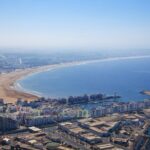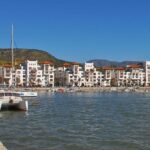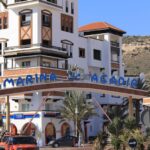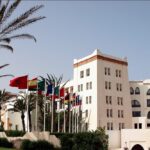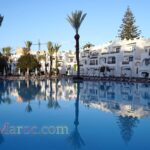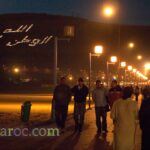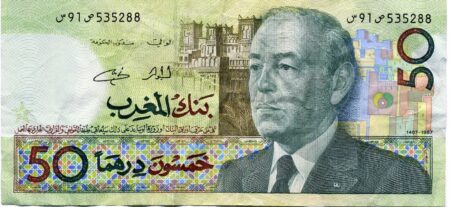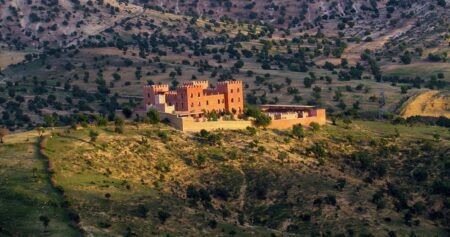The Sous-Massa region is investing heavily in developing its tourism offering and infrastructure, and in boosting this activity.
Living or staying in Agadir, the white citadel
A modern city
Agadir takes its name from a Berber word meaning fortified village or granary.
Initially it was a Berber fishing village, fortified, and used by the Ksima tribe. In this “Porto Meseguinam”, Portuguese sailors then engaged in piracy and smuggling. In 1505, João Lopes de Sequeira built a fortress at the foot of the hill to prevent access to the harbour, and in 1513 King Manuel I made this takeover official by buying back the fort and installing a garrison. Agadir was then called Santa Cruz de Cabo de Aguer (Cape of the Ford), and secured the land and sea routes of the gold and slave traffic (Sudan, Guinea…)

But the tribes of the region united, under the authority of the Saâdiens, and, on 12 March 1541, after six months of siege, the Portuguese capitulated and abandoned Agadir. The region would go into dissidence with the arrival of the Alawites who, in retaliation, once their authority was restored, closed Agadir.
.
The city will be reborn with the entry of the French, in 1913. The busiest tourist resort in Morocco then had less than 7,000 inhabitants! With the Aéropostale, and above all with fishing (Agadir vies with Safi for the title of the world’s leading sardine port), the city takes off, brutally stopped on February 29, 1960 with a deadly earthquake (more than fifteen thousand dead) and destructive.
Agadir was almost completely destroyed, and rebuilt from scratch, starting in 1962, on seismically safe ground. The reconstruction was planned, organised, and Agadir’s little-known architectural heritage reflects this planning, with many buildings typical of the rough architecture of the 1960s.

Today it is a modern seaside resort, international, where German, English and even Russian signs mingle with French and Arabic ones, lively, which differs little from those one might find anywhere in France or Spain. Nothing remains of the Portuguese buildings, and only a few fortifications of the old Berber Agadir.

Agadir has other activities than tourism: it is a large fishing port, particularly sardine. It is also the commercial centre of the Sous, where the productions of the large farms of the region arrive (tomatoes, fruits, vegetables), which are then sent by truck to Europe. Finally, it is a important university town. All this gives it a real liveliness, and it is also possible to live Moroccan-style in Agadir.
Photos of Agadir and the surrounding area
To visit in and around Agadir:
The citadel
The ancient ramparts have been rebuilt on the heights of Agadir, the citadel is reminiscent of the old medina. From the top, there is a superb view of the bay and the 6 kilometres of beach. The rest of the site was bulldozed after the earthquake, and is in fact a huge necropolis.
The medina
The medina
Completely reconstructed in the 1990s, Agadir’s medina is a successful reconstruction that houses around 100 quality craftsmen. A must-see, but avoid the tour buses.

The Crocopark
An original and unique place in Morocco, the Crocoparc of Agadir brings together hundreds of saurians, iguanas, turtles, pythons, anacondas and even marmosets. It also offers walks in a huge botanical garden organised by theme (cacti, blue succulents, etc.) and activities such as tree climbing.

Tiznit and Aglou
About an hour from Agadir lies Tiznit, the capital of the silver smiths of Morocco. A quiet little town with little of real interest apart from the jewellers’ stalls. But 15km to the north is the small town of Aglou, with its beautiful coastline, and the little fishermen’s huts clinging to the beachfront.

Imouzzer of Ida Touatane
High up in the Anti-Atlas, Imouzzer is a small Berber village with superb waterfalls. The path is easy, well laid out (and quite crowded at weekends). The waterfalls themselves are very beautiful, and this excursion, which can be done in half a day, is a pleasant break from the seaside atmosphere of Agadir.
.
The Sous Massa
reserve.
Ornithological reserve where many migratory birds pass, it is best visited with a guide. At certain times (especially during the nesting season) access may be limited.
Agadir: practical information
Coming to Agadir
Agadir is one of the two biggest tourist destinations in Morocco, along with Marrakesh. It is therefore easy to find cheap flights to Agadir, especially in the low season, with regular airlines, such as RAM and Air France being heavily competed with by low-cost carriers, Corsair, TUI, Easy-Jet, Transavia, Atlas-Blue… plan ahead, and take the time to look for the right deal.
The car journey
The journey by car can be quite long, the motorway junction from Marrakesh has been opened, nevertheless the crossing from France to Agadir, life Spain and Tangier should take several days.
The CTM buses serve Agadir well. It is in fact the only possibility by public transport, since the train does not go down south of Marrakesh. But one day the TGV will allow you to do Tangier – Agadir directly!
Shopping, restaurants and hotels in Agadir

You can find everything in Agadir, luxury hotels, golf hotels, along the corniche, small cheap hotels, and flat hotels where you can rent a large room with bathroom and kitchenette for about 250 dirhams/day in the off season. It is also relatively easy to find flats in private homes, often rented on the black market, again at fairly low prices.
For restaurants, it is possible to rent a large room with a bathroom and kitchen for about 250 dirhams/day in the off-season.
For restaurants, our preference is for small fish grills at the port. Be careful… some restaurants have set up right at the entrance, you have to pass them to enter a large space filled with tables with benches. Each stall offers grilled fish, “samak mechoua” (grilled or fried fish) at very low prices. Just choose a table you like, and order… the dish will be plentiful.
.
There is little typical shopping in Agadir. Except perhaps precisely in the medina, which gathers quality craftsmen.
The weather is very good.
Weather and climate of Agadir
. <Rainfall. .
| (C° and mm) | Min. temp | |||
| January | 9 | 20 | 46 | 8 |
|---|---|---|---|---|
| February | 9 | 22 | 43 | 8 |
| March | 11 | 22 | 30 | 9 |
| April | 12 | 24 | 25 | 10 |
| May | 15 | 24 | 3 | 10 |
| June | 16 | 26 | 0 | 10 |
| July | 18 | 27 | 0 | 9 |
| August | 18 | 27 | 0 | 9 |
| September | 17 | 27 | 3 | 9 |
| October | 15 | 26 | 25 | 8 |
| November | 12 | 23 | 53 | 8 |
| December | 8 | 20 | 61 | 7 |
Already well south, Agadir enjoys a remarkable climate, with an average of more than 300 days of sunshine a year, a mild and sunny winter…
You can bathe there even in winter, if its waters are not tropical, they are definitely warmer than those of Essaouira!
Agadir has everything to seduce, except perhaps its frequent fogs in summer, and the cold snaps that can surprise, in July or August. On the seaside, it rarely experiences the sweltering heat that can be experienced in Fez or Marrakesh.

